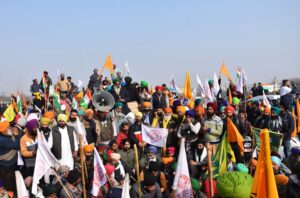-
India’s worsening water crisis at the heart of farm protests

Every year, Swarn Singh sows rice in his fields, knowing that the thirsty crop is draining northern India’s Punjab of its groundwater. But Singh says he has no choice, adding, “We’d rather plant crops that need less water.”
The 32-year-old farmer and school teacher lives in Ransih Kalan village in the state’s Moga district, where green fields surrounding its wide roads and large houses belie the reality that the region is among India’s most parched and its once-prosperous agricultural system is now broken.
India’s water crisis looms over an agrarian crisis that has been brewing for decades. At its heart is a conundrum: the government has been subsidizing the cultivation of rice in northern India, but such water-intensive crops have dramatically lowered the groundwater table.
Every third house in Ransih Kalan — a community of nearly 3,000, less than 100 kilometers (62 miles) from India’s border with Pakistan — bears flags supporting thousands of farmers hunkered down outside New Delhi since November to protest three laws Prime Minister Narendra Modi says will modernize agriculture.
Singh says his village’s farmers agree changes are needed but fear these laws will only make matters worse, leaving them at the mercy of big corporations. The laws don’t address the region’s water crisis. But Singh said that if guaranteed prices for all crops were to become a legal right, farmers would shift away from thirsty crops.
Home to a fifth of the world’s population, India has only 4 percent of the world’s water. But the country is the largest extractor of groundwater in the world, with 90 percent used for agriculture.
Nowhere is the water shortage more pronounced than in Punjab, where India’s government encouraged cultivation of wheat and rice in the 1960s and has since been buying the staples at fixed prices to shore up national reserves.
Wheat was a traditional crop, along with mung beans or peanuts, said Singh’s father, Bhupinder Singh, 62. But he and experts say a pound of rice needs up to 500 gallons (2,273 liters) of water — and irrigation canals couldn’t supply enough as more farmers switched to the grain.
Farmers turned to well water. When the government started providing free electricity to run well pumps in 1997, Punjab rice raising rocketed — from 500 square kilometers (193 square miles) in 1975 to 31,000 square kilometers (11,969 square miles).
But groundwater levels plummeted as underground pumps proliferated, with over 1.2 million by 2012. And a 2017 federal report warned that the state of 27 million people would exhaust its groundwater by 2039.
“It’s becoming a desert,” said Kirpal Singh Aulakh, an agricultural scientist and former vice chancellor of Punjab Agricultural University.
The looming calamity isn’t news to the Singhs. They had to spend $6,600 to install a pump for a nearly 200-foot (60-meter) borehole. And successive years of planting the same crops leached their village’s soil of nutrients, forcing them to rely on expensive fertilizers.
Rising costs have forced the family into debt, and the certainty of selling to their crops to the government is their only way of staying afloat. “All of Punjab is trapped,” the son said.
Protesting farmers fear the new laws signal that the government wants to reduce its role in agriculture and that guaranteed prices for their crops will end.
The government does fix prices for crops other than wheat and rice, including corn. But Aulakh said these products aren’t purchased for federal reserves and traders in the private market pay much lower prices for them, resulting in farmers feeling “cheated.”
 Farmers participate in a protest march towards the capital during India's Republic Day celebrations in New Delhi, India, Tuesday, Jan. 26, 2021. (AP)
Farmers participate in a protest march towards the capital during India's Republic Day celebrations in New Delhi, India, Tuesday, Jan. 26, 2021. (AP)Aulakh, who has sat on government committees that discussed crop diversification in Punjab, said farmers would switch to more suitable crops if they knew they’d be compensated by the government. “We can’t blame the farmers,” he said.
India’s agricultural and water ministries did not respond to emailed requests for comment.
More than 86 percent of India’s farmers work on less than than 2 hectares (4.9 acres). So the falling groundwater table means these small farmers spend increasingly more money to pump water for their crops and this is widening inequity, said Balsher Singh Sidhu, a University of British Columbia doctoral student studying climate change impacts on agriculture.
Sidhu compared the available groundwater to a bank account where withdrawals far exceed deposits. “Today everyone has access to water, but we can’t say the same about tomorrow,” he said.
Climate change has made the monsoon rains -- a lifeline for over half of India’s cultivated area -- unpredictable and left farmers even more reliant on groundwater. Rice requires standing water in fields. But hotter summers are increasing the amount lost due to evaporation.
Rice farmer Mahinder Singh, 73, said he tried planting corn once but private buyers paid him only a fraction of the prices set by the government. “We will die of hunger,” if the water runs out, he added.
India’s food reserves are overflowing, leading to waste, but malnutrition is intensifying and experts fear future water shortages could make it worse.
“The richer people can afford to (buy) fruits and vegetables,” said Upmanu Lall, director of the Columbia Water Center at Columbia University. “Poor people do not, other than what they can scavenge.”
Residents of Ransih Kalan have begun taking steps to conserve water.
Villagers have installed a sewage treatment plant, and the treated water is used for irrigation. They’ve also built plants to harvest rainwater and divert it into a man-made lake. In the middle is a 10-foot tall (3 meters) statue of a dinosaur.
It’s a reminder, says Preet Inderpal Singh, the 30-year-old village headman, “That if people don’t save every drop of water, people would become extinct, like dinosaurs.”
source: The Associated Press
Image source: Reuters
Levant
You May Also Like
Popular Posts
Caricature
BENEFIT AGM approves 10%...
- March 27, 2025
BENEFIT, the Kingdom’s innovator and leading company in Fintech and electronic financial transactions service, held its Annual General Meeting (AGM) at the company’s headquarters in the Seef District.
During the meeting, shareholders approved all items listed on the agenda, including the ratification of the minutes of the previous AGM held on 26 March 2024. The session reviewed and approved the Board’s Annual Report on the company’s activities and financial performance for the fiscal year ended 31 December 2024, and the shareholders expressed their satisfaction with the company’s operational and financial results during the reporting period.
The meeting also reviewed the Independent External Auditor’s Report on the company’s consolidated financial statements for the year ended 31 December 2024. Subsequently, the shareholders approved the audited financial statements for the fiscal year. Based on the Board’s recommendation, the shareholders approved the distribution of a cash dividend equivalent to 10% of the paid-up share capital.
Furthermore, the shareholders endorsed the allocation of a total amount of BD 172,500 as remuneration to the members of the Board for the year ended 31 December 2024, subject to prior clearance by related authorities.
The extension of the current composition of the Board was approved, which includes ten members and one CBB observer, for a further six-month term, expiring in September 2025, pending no objection from the CBB.
The meeting reviewed and approved the Corporate Governance Report for 2024, which affirmed the company’s full compliance with the corporate governance directives issued by the CBB and other applicable regulatory frameworks. The AGM absolved the Board Members of liability for any of their actions during the year ending on 31st December 2024, in accordance with the Commercial Companies Law.
In alignment with regulatory requirements, the session approved the reappointment of Ernst & Young (EY) as the company’s External Auditors for the fiscal year 2025, covering both the parent company and its subsidiaries—Sinnad and Bahrain FinTech Bay. The Board was authorised to determine the external auditors’ professional fees, subject to approval from the CBB, and the meeting concluded with a discussion of any additional issues as per Article (207) of the Commercial Companies Law.
Speaking on the company’s performance, Mr. Mohamed Al Bastaki, Chairman BENEFIT , stated: “In terms of the financial results for 2024, I am pleased to say that the year gone by has also been proved to be a success in delivering tangible results. Growth rate for 2024 was 19 per cent. Revenue for the year was BD 17 M (US$ 45.3 Million) and net profit was 2 Million ($ 5.3 Million).
Mr. Al Bastaki also announced that the Board had formally adopted a new three-year strategic roadmap to commence in 2025. The strategy encompasses a phased international expansion, optimisation of internal operations, enhanced revenue diversification, long-term sustainability initiatives, and the advancement of innovation and digital transformation initiatives across all service lines.
“I extend my sincere appreciation to the CBB for its continued support of BENEFIT and its pivotal role in fostering a stable and progressive regulatory environment for the Kingdom’s banking and financial sector—an environment that has significantly reinforced Bahrain’s standing as a leading financial hub in the region,” said Mr. Al Bastaki. “I would also like to thank our partner banks and valued customers for their trust, and our shareholders for their ongoing encouragement. The achievements of 2024 set a strong precedent, and I am confident they will serve as a foundation for yet another successful and impactful year ahead.”
Chief Executive of BENEFIT; Mr. Abdulwahed AlJanahi commented, “The year 2024 represented another pivotal chapter in BENEFIT ’s evolution. We achieved substantial progress in advancing our digital strategy across multiple sectors, while reinforcing our long-term commitment to the development of Bahrain’s financial services and payments landscape. Throughout the year, we remained firmly aligned with our objective of delivering measurable value to our shareholders, strategic partners, and customers. At the same time, we continued to play an active role in enabling Bahrain’s digital economy by introducing innovative solutions and service enhancements that directly address market needs and future opportunities.”
Mr. AlJanahi affirmed that BENEFIT has successfully developed a robust and well-integrated payment network that connects individuals and businesses across Bahrain, accelerating the adoption of emerging technologies in the banking and financial services sector and reinforcing Bahrain’s position as a growing fintech hub, and added, “Our achievements of the past year reflect a long-term vision to establish a resilient electronic payment infrastructure that supports the Kingdom’s digital economy. Key developments in 2024 included the implementation of central authentication for open banking via BENEFIT Pay”
Mr. AlJanahi concluded by thanking the Board for its strategic direction, the company’s staff for their continued dedication, and the Central Bank of Bahrain, member banks, and shareholders for their valuable partnership and confidence in the company’s long-term vision.
opinion
Report
ads
Newsletter
Subscribe to our mailing list to get the new updates!





















